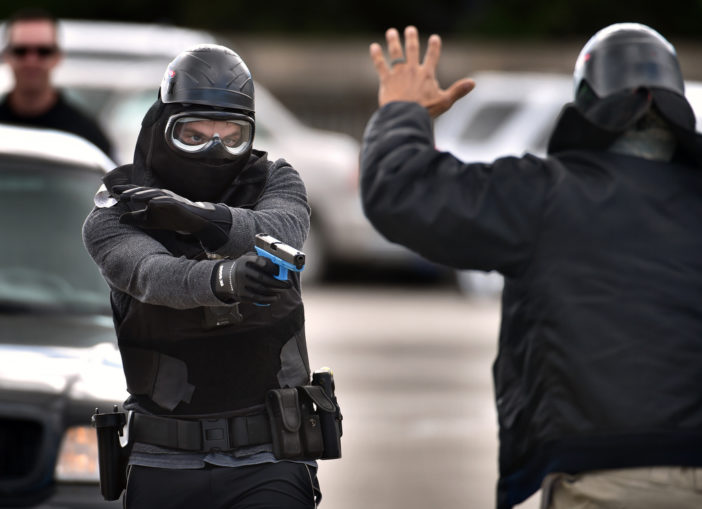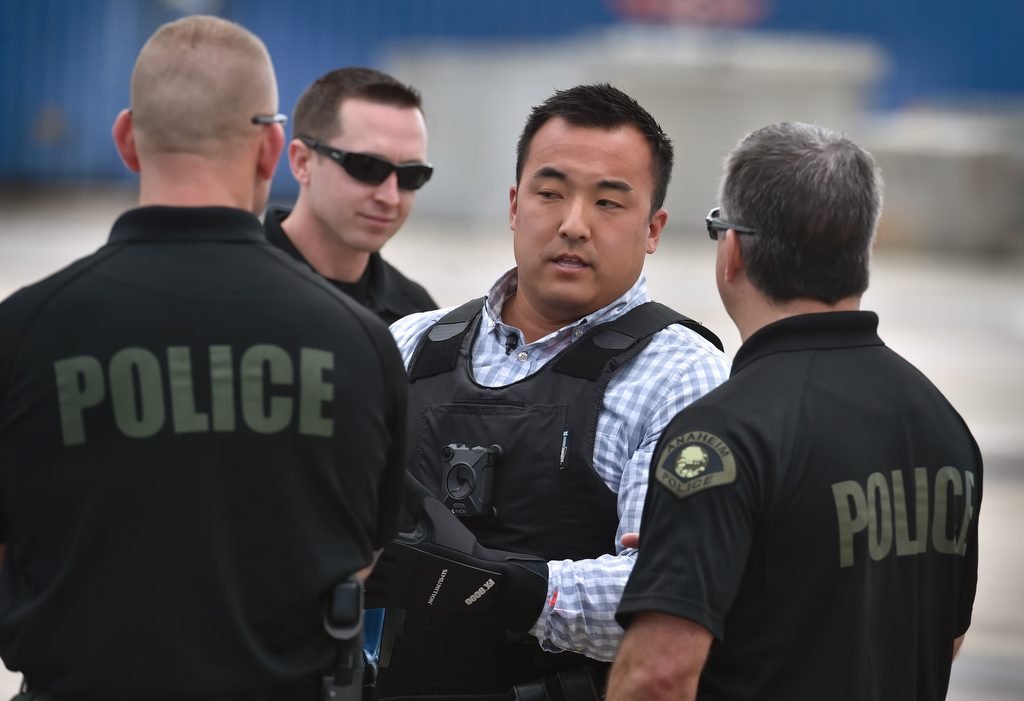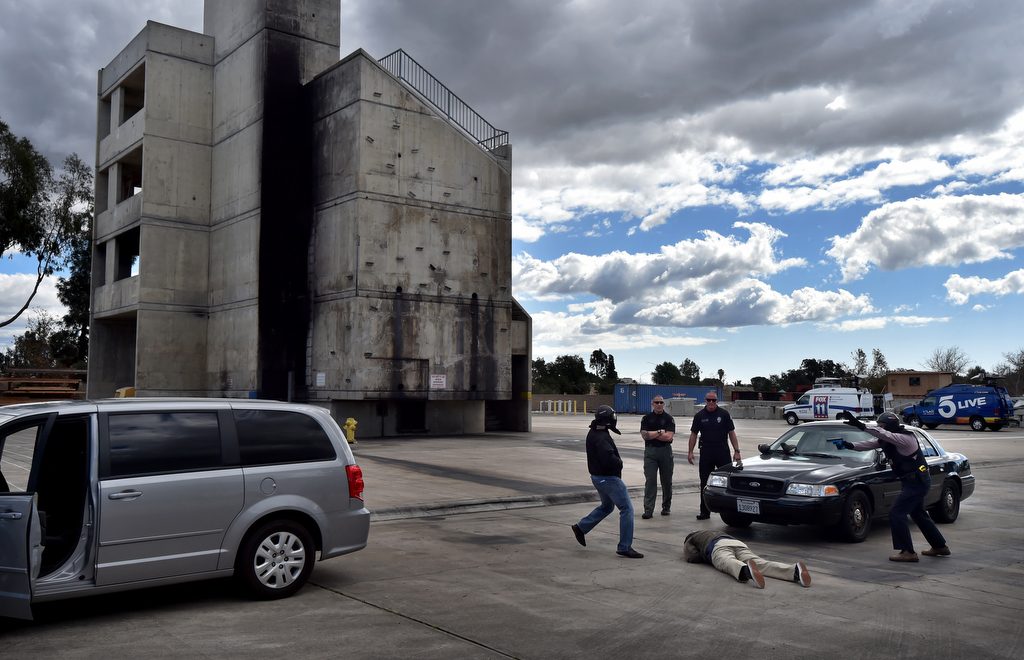With a gun on one hip and a Taser on the other, local reporters had a taste of what it feels like to be a police officer during Anaheim Police Department’s Use of Force Day.
Anaheim officers presented an overview of police training, including information on safety during vehicle stops, how officers and their partners cover each other during contact with people in the field, and statistics on police use of force.

An APD officer playing the part of a civilian driver holds up a black wallet that, at first glance, has the appearance of being a gun as a member of the media, right, participates in a simulation where he plays the part of an officer who pulled a driver over.
Photo by Steven Georges/Behind the Badge OC
In Anaheim, officers used force during less than 1 percent of the 205,000 contacts the Anaheim Police Department made in 2016 (the most recent year’s statistics are not yet available), Public Information Officer Sgt. Daron Wyatt said.
“It’s remarkable how little force is ever used,” Acting Chief Julian Harvey said.
That includes all types of force, including Taser, physical contact, batons, or guns. When zeroed in on only deadly force, the number is even more miniscule, officials stated.
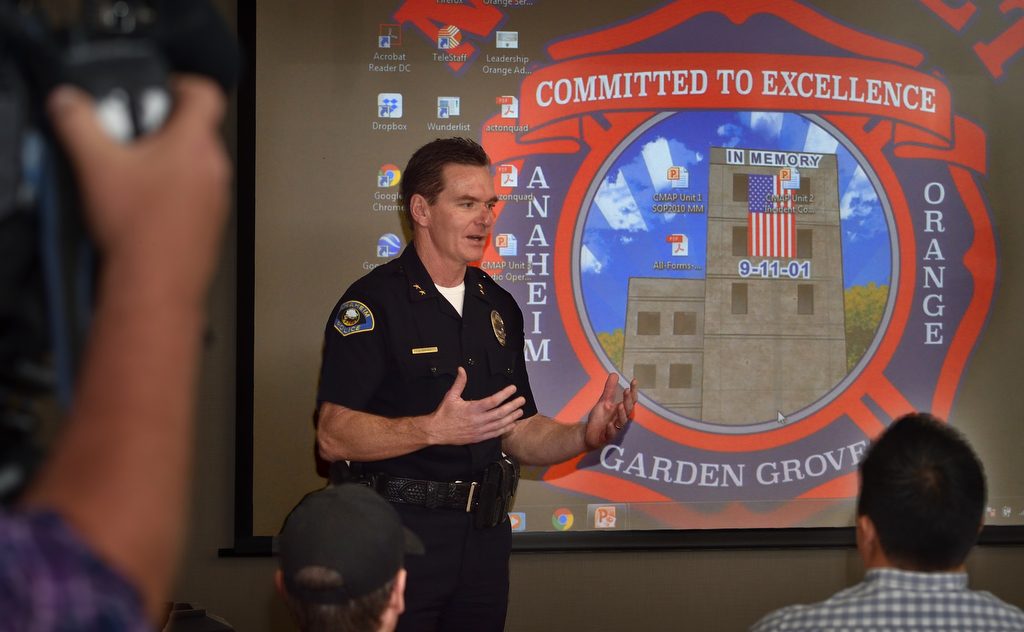
Anaheim PD Acting Chief Julian Harvey talks to members of the press gathered to participate in a use of force training exercise at the North Net Training Center in Anaheim.
Photo by Steven Georges/Behind the Badge OC
“The media reports on these uses of force but they never have it really in context with how often it does or does not occur,” Wyatt said.
Before the simulation, the seven reporters had to suit up in a bullet-proof vest, helmet, body camera, and belt that contained a Simunition gun and Taser (with batteries and cartridges removed for safety).
The event allowed participants to experience the stress and adrenaline of situations that could quickly turn deadly.

ABC7 News Reporter Greg Lee pulls out his simunition gun during a use of force simulation put on by the Anaheim PD.
Photo by Steven Georges/Behind the Badge OC
“Use of force is a very controversial topic, and often the controversy comes from a lack of understanding,” Harvey said. “The Use of Force Day for the media is our chance to raise the level of awareness and understanding for members of the media who often respond to these situations.”
“Unlike most professions, we insert our officers into inherently dangerous situations, inherently volatile situations. That’s their job,” Harvey said.
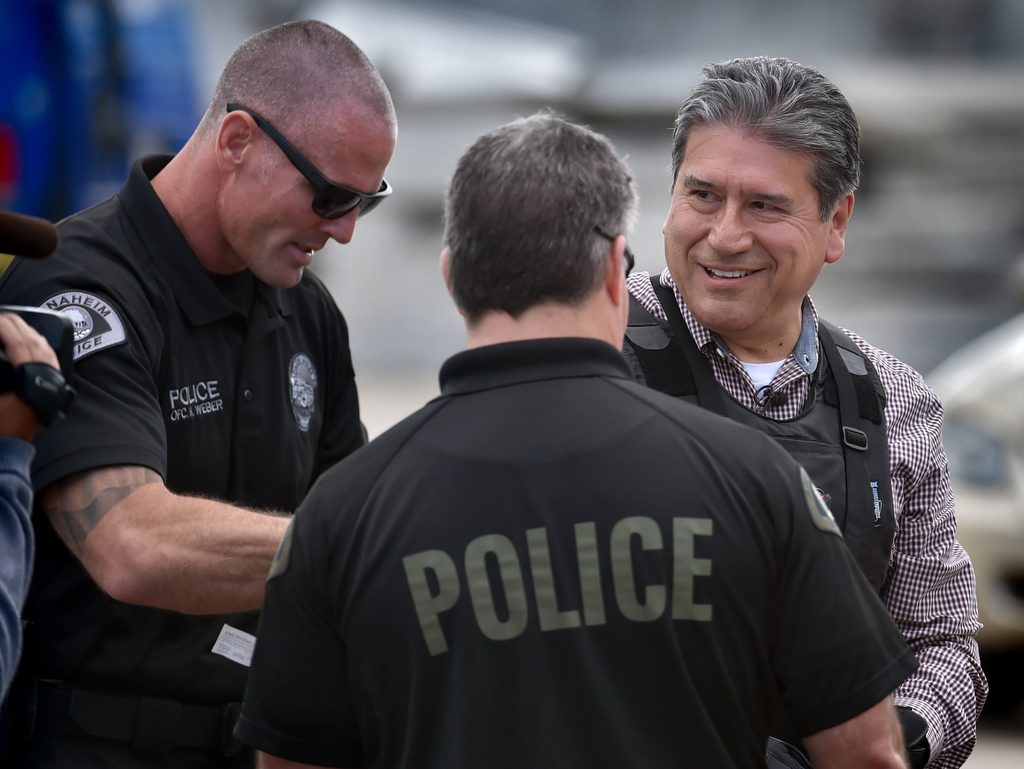
Martin Plascencia, Orange County news reporter for Telemundo Channel 52, talks to Anaheim PD Officer Ken Weber, left, and Sgt. Kelly Phillips about his experience running through the same training exercise, based on actual events, that police officers are trained on.
Photo by Steven Georges/Behind the Badge OC
The first scenario of the day was a traffic stop, with an uncooperative driver and passenger in a gray minivan parked at a curb at the North Net Training Center in Anaheim. Each person handled the situation differently, and not all encounters ended in a shoot-out.
“It’s terrifying, it’s exhilarating, it’s exciting,” ABC7 Orange County reporter Greg Lee said. “My heart was beating out of my chest. I think it’s a glimpse into how quickly these things play out, because you think that these guys have all the time in the world to make a decision, but it’s literally less than a second.”
The scenarios, Harvey said, demonstrate how a situation can quickly evolve from one where everyone is cooperating to a dangerous chaos.
KFI Reporter Kris Ankarlo said he replayed his first scenario in his mind several times, thinking of things he could have done differently. Only afterward did he realize he could have called for backup or used the Taser.
“There’s uncertainty about how to move forward,” Ankarlo said. “I wasn’t really sure what questions I should ask. At what point do I ask someone to get out of a car? At what point do you shoot someone?”
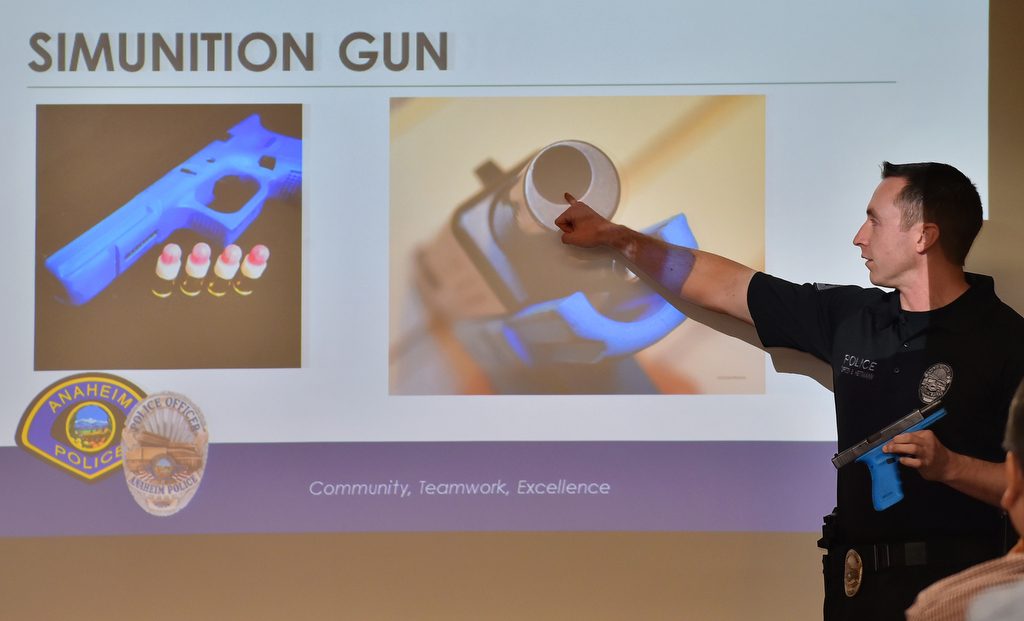
APD Officer Brett Heitmann demonstrates the proper way to handle the blue simunition gun that uses practice ammunition similar to paint balls, to be used in a use of force training exercise.
Photo by Steven Georges/Behind the Badge OC
The officers provided feedback after the scenarios ended, and participants could view their body camera footage.
“More than anything it’s frustrating because you look back and there were so many things you could have done differently,” Lee said. “It’s so easy to freeze up, even knowing the gun is fake and knowing that guy’s a police officer. I don’t see that fear every day.”
Officer Mark Berger, who is part of Anaheim Police Department’s training detail, said most simulations are done via video game (such as the Firearms Training Systems simulator), but said the Use of Force Day event scenarios were more realistic.
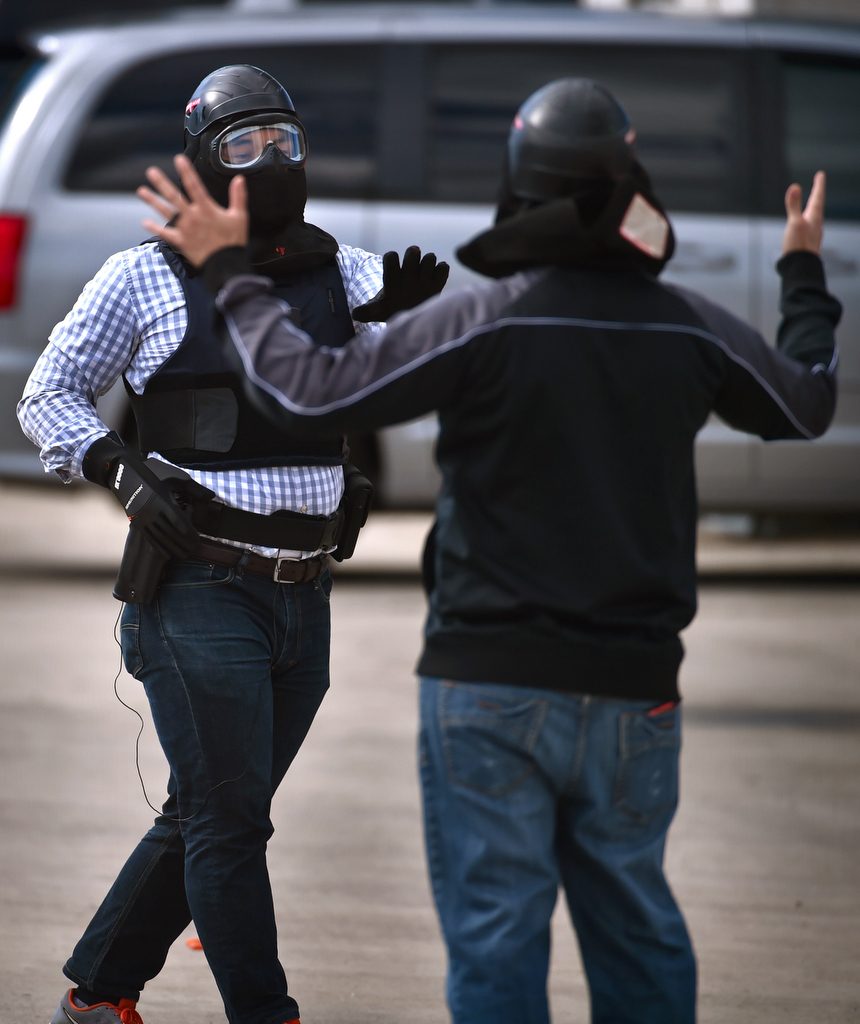
ABC7 News reporter Greg Lee tries to talk down an uncooperative civilian, played by an Anaheim PD officer, during a use of force exercise. Both participants wear proactive gear as the simulation guns do fire propellants similar to paint guns.
Photo by Steven Georges/Behind the Badge OC
“The machine doesn’t shoot back,” Harvey said. “We’re actually putting you into a crown Victoria police car and putting the equipment on you.”
“It adds this element of reality that changes things immediately,” he said.
Officers train this way as well to keep their skills and judgement honed, Wyatt said.
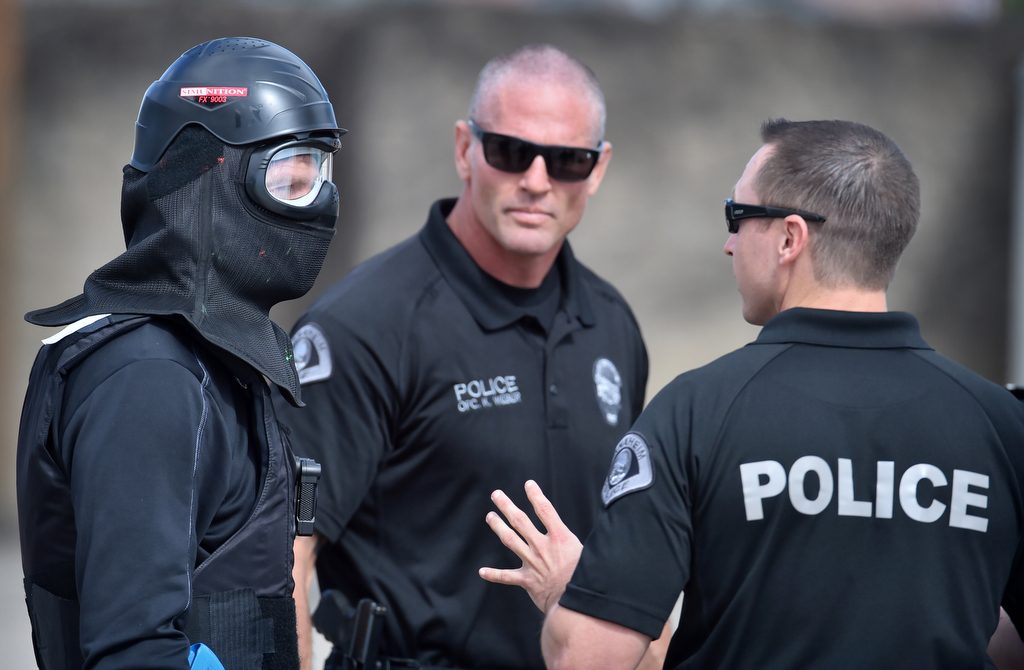
Officers Ken Weber and Brett Heitmann, right, instruct a member of the media, left, before taking part in a use of force training exercise.
Photo by Steven Georges/Behind the Badge OC
“It opens your eyes to what we, as police officers, encounter and what it actually feels like to be in a situation,” Berger said.
Martin Plascencia, Orange County news reporter for Telemundo Channel 52, said he was nervous because he didn’t know how the scenario would play out. His situation ended when he shot both the driver and passenger as they walked toward him with their hands hidden, despite his orders for them to stop and put their hands in the air.

Martin Plascencia, Orange County news reporter for Telemundo Channel 52, who just went through a use of force simulation that resulted in him pulling his weapon and shooting the suspect, talks to his lawyer during a mock police internal inquiry that simulates what an officer would go through in the same situation.
Photo by Steven Georges/Behind the Badge OC
“It was a really good experience,” Plascencia said. “We had the chance to see the other side, what the officer has to go through, and that will give you another perspective when those violent incidents happen in the community.”
If citizens comply with officers’ commands in the field, even if they don’t agree, it will greatly reduce the likelihood a use of force will occur, Wyatt said, adding that there’s a way for citizens to contest police actions afterward.
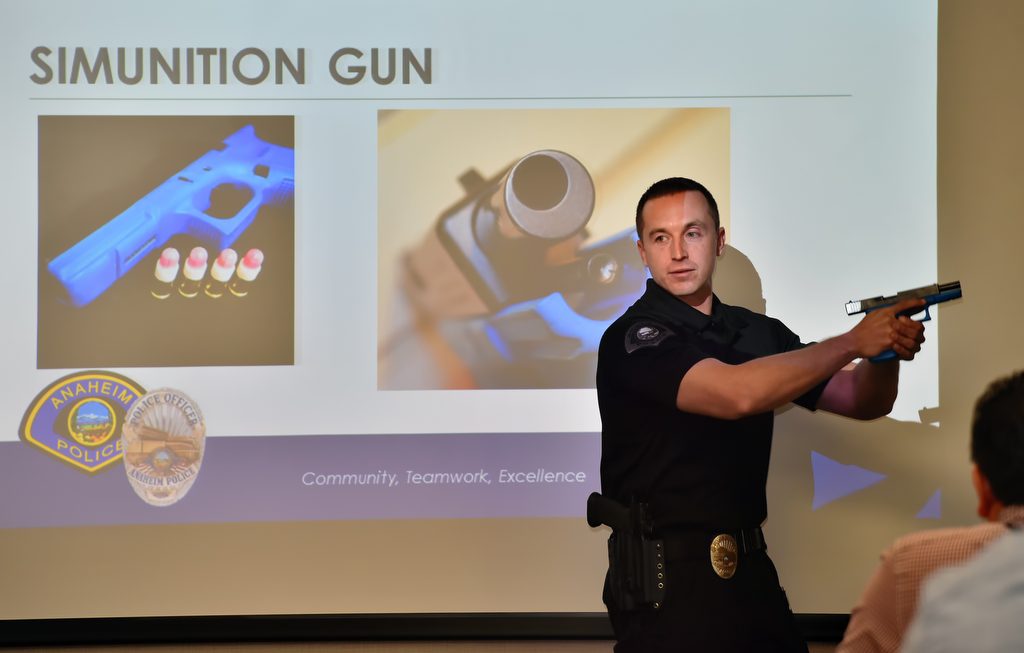
APD Officer Brett Heitmann demonstrates the proper way to handle the blue simunition gun that uses practice ammunition similar to paint balls, to be used in the use of force training exercise.
Photo by Steven Georges/Behind the Badge OC
After removing his police gear, Plascencia was advised by a mock police attorney and interviewed by two mock District Attorneys about the shootings.
“Now I have an idea of all the things they have to go through,” Plascencia said. “I felt like it was real.”
 Behind the Badge
Behind the Badge
